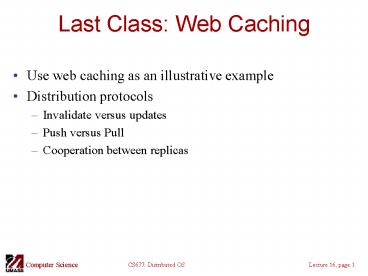Last Class: Web Caching PowerPoint PPT Presentation
Title: Last Class: Web Caching
1
Last Class Web Caching
- Use web caching as an illustrative example
- Distribution protocols
- Invalidate versus updates
- Push versus Pull
- Cooperation between replicas
2
Today More on Consistency
- Eventual consistency and Epidemic protocols
- Consistency protocols
- Primary-based
- Replicated-write
- Putting it all together
- Final thoughts
3
Eventual Consistency
- Many systems one or few processes perform
updates - How frequently should these updates be made
available to other read-only processes? - Examples
- DNS single naming authority per domain
- Only naming authority allowed updates (no
write-write conflicts) - How should read-write conflicts (consistency) be
addressed? - NIS user information database in Unix systems
- Only sys-admins update database, users only read
data - Only user updates are changes to password
4
Eventual Consistency
- Assume a replicated database with few updaters
and many readers - Eventual consistency in absence of updates, all
replicas converge towards identical copies - Only requirement an update should eventually
propagate to all replicas - Cheap to implement no or infrequent write-write
conflicts - Things work fine so long as user accesses same
replica - What if they dont
5
Client-centric Consistency Models
- Assume read operations by a single process P at
two different local copies of the same data store - Four different consistency semantics
- Monotonic reads
- Once read, subsequent reads on that data items
return same or more recent values - Monotonic writes
- A write must be propagated to all replicas before
a successive write by the same process - Resembles FIFO consistency (writes from same
process are processed in same order) - Read your writes read(x) always returns write(x)
by that process - Writes follow reads write(x) following read(x)
will take place on same or more recent version of
x
6
Epidemic Protocols
- Used in Bayou system from Xerox PARC
- Bayou weakly connected replicas
- Useful in mobile computing (mobile laptops)
- Useful in wide area distributed databases (weak
connectivity) - Based on theory of epidemics (spreading
infectious diseases) - Upon an update, try to infect other replicas as
quickly as possible - Pair-wise exchange of updates (like pair-wise
spreading of a disease) - Terminology
- Infective store store with an update it is
willing to spread - Susceptible store store that is not yet updated
- Many algorithms possible to spread updates
7
Spreading an Epidemic
- Anti-entropy
- Server P picks a server Q at random and exchanges
updates - Three possibilities only push, only pull, both
push and pull - Claim A pure push-based approach does not help
spread updates quickly (Why?) - Pull or initial push with pull work better
- Rumor mongering (aka gossiping)
- Upon receiving an update, P tries to push to Q
- If Q already received the update, stop spreading
with prob 1/k - Analogous to hot gossip items gt stop spreading
if cold - Does not guarantee that all replicas receive
updates - Chances of staying susceptible s e-(k1)(1-s)
8
Removing Data
- Deletion of data items is hard in epidemic
protocols - Example server deletes data item x
- No state information is preserved
- Cant distinguish between a deleted copy and no
copy! - Solution death certificates
- Treat deletes as updates and spread a death
certificate - Mark copy as deleted but dont delete
- Need an eventual clean up
- Clean up dormant death certificates
9
Implementation Issues
- Two techniques to implement consistency models
- Primary-based protocols
- Assume a primary replica for each data item
- Primary responsible for coordinating all writes
- Replicated write protocols
- No primary is assumed for a data item
- Writes can take place at any replica
10
Remote-Write Protocols
- Traditionally used in client-server systems
11
Remote-Write Protocols (2)
- Primary-backup protocol
- Allow local reads, sent writes to primary
- Block on write until all replicas are notified
- Implements sequential consistency
12
Local-Write Protocols (1)
- Primary-based local-write protocol in which a
single copy is migrated between processes. - Limitation need to track the primary for each
data item
13
Local-Write Protocols (2)
- Primary-backup protocol in which the primary
migrates to the process wanting to perform an
update
14
Replicated-write Protocols
- Relax the assumption of one primary
- No primary, any replica is allowed to update
- Consistency is more complex to achieve
- Quorum-based protocols
- Use voting to request/acquire permissions from
replicas - Consider a file replicated on N servers
- Update contact at least (N/21) servers and get
them to agree to do update (associate version
number with file) - Read contact majority of servers and obtain
version number - If majority of servers agree on a version number,
read
15
Giffords Quorum-Based Protocol
- Three examples of the voting algorithm
- A correct choice of read and write set
- A choice that may lead to write-write conflicts
- A correct choice, known as ROWA (read one, write
all)
16
Final Thoughts
- Replication and caching improve performance in
distributed systems - Consistency of replicated data is crucial
- Many consistency semantics (models) possible
- Need to pick appropriate model depending on the
application - Example web caching weak consistency is OK
since humans are tolerant to stale information
(can reload browser) - Implementation overheads and complexity grows if
stronger guarantees are desired

